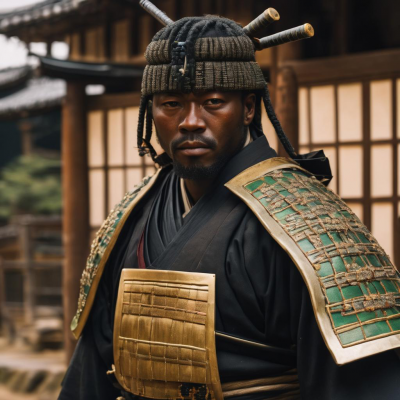Famous Persons of African Heritage: Sakanoue No Tamuramaro, Japan

Sakanoue no Tamuramaro: The Black Shogun of Early Japan
In the annals of Japanese history, few figures stand as prominently as Sakanoue no Tamuramaro. Born in 758 AD, Tamuramaro rose to become Japan’s first Sei-i Taishōgun, or “Barbarian-Subduing Generalissimo,” during the early Heian period. His military prowess and leadership were instrumental in subjugating the Emishi people of northern Honshū, solidifying the central government’s control over the region.
A Military Legacy
Tamuramaro’s military campaigns were marked by strategic brilliance and unwavering dedication. Under Emperor Kanmu’s directive, he led expeditions against the Emishi, establishing fortresses at Izawa and Shiwa to secure the northern frontiers. His successes earned him not only the prestigious title of Sei-i Taishōgun but also high-ranking positions within the imperial court, including Minister of War and Great Counselor.
Beyond the battlefield, Tamuramaro contributed to cultural and religious developments. He is credited with founding the Kiyomizu-dera Temple in Kyoto, a UNESCO World Heritage site that continues to attract visitors worldwide.
Debates on Ancestry
While Tamuramaro’s military and political achievements are well-documented, discussions about his ancestry have sparked scholarly debates. Some Afrocentric scholars, including Alexander Francis Chamberlain and W.E.B. Du Bois, have posited that Tamuramaro may have had African heritage. These claims are based on interpretations of historical texts and physical descriptions, suggesting a possible African presence in early Japan.
However, mainstream historians often view these assertions with skepticism, citing a lack of concrete evidence. The Sakanoue clan, to which Tamuramaro belonged, claimed descent from Emperor Ling of the Chinese Han dynasty, indicating East Asian origins. The debate underscores the complexities of tracing lineage and the importance of critical analysis in historical scholarship.
Early Life and Rise to Power
Born into the Sakanoue clan, Tamuramaro’s lineage is traced back to Emperor Ling of the Chinese Han dynasty, indicating a prestigious heritage. His father, Sakanoue no Karitamaro, also served in the imperial court, setting a precedent for Tamuramaro’s future service.
Tamuramaro’s military career flourished under Emperor Kanmu, who recognized his strategic acumen and leadership abilities. In 797, he was appointed as Sei-i Taishōgun, tasked with leading campaigns against the Emishi, indigenous people resisting imperial rule in the north. His successful campaigns not only subdued the Emishi but also facilitated the integration of their territories into the Japanese state.
Military Achievements
Tamuramaro’s campaigns were marked by innovative strategies and effective use of resources. He established fortresses at Izawa and Shiwa, strengthening Japan’s northern defenses. His military successes earned him high-ranking positions, including Dainagon (Great Counselor) and Minister of War. In 810, he played a pivotal role in suppressing an attempt to restore the retired Emperor Heizei to the throne, further solidifying his reputation as a loyal and capable leader.
Cultural Contributions
Beyond his military accomplishments, Tamuramaro made significant cultural contributions, most notably the founding of Kiyomizu-dera, a renowned Buddhist temple in Kyoto. According to legend, during a hunting expedition, he encountered the monk Enchin at the Otowa Waterfall. Moved by Enchin’s teachings, Tamuramaro assisted in establishing the temple, which became a significant religious site and is now part of the Historic Monuments of Ancient Kyoto UNESCO World Heritage Site.
Legacy and Historical Significance
Tamuramaro’s legacy endures in various facets of Japanese culture. He is often depicted as an ideal warrior, embodying the virtues of bravery, loyalty, and humility. His role in expanding Japan’s territory and integrating diverse cultures laid the groundwork for the nation’s future unification. Additionally, his contributions to religious and cultural institutions like Kiyomizu-dera highlight the multifaceted impact of his leadership.
In recognition of his service, Tamuramaro was posthumously awarded the Senior Second Rank, and his tomb, known as Shogun-zuka, remains a site of historical interest in Kyoto.
Cultural Impact
Tamuramaro’s legacy extends beyond his lifetime. He is celebrated in Japanese folklore and is associated with various legends, including tales of slaying demons and protecting the realm. Festivals like the Nebuta Matsuri in Aomori Prefecture are believed to commemorate his military campaigns, featuring illuminated floats that symbolize his strategic use of lanterns to outmaneuver enemies.
His tomb, located in Kyoto, remains a site of historical significance. While some legends suggest it is at Shōgun-zuka, historical records indicate his burial site is in Kanshuji Higashikurisunocho, Yamashina Ward, Kyoto.
Conclusion
Sakanoue no Tamuramaro’s life encapsulates the dynamic interplay between military conquest and cultural development in early Japan. As the first Sei-i Taishōgun, his leadership not only expanded the nation’s borders but also enriched its cultural and religious landscape.
Sakanoue no Tamuramaro’s contributions to Japan’s military and cultural history are undeniable. As the first shogun, his strategies and leadership set precedents for future generations. While debates about his ancestry rage, they highlight the broader discussions on diversity and representation in historical narratives. Tamuramaro’s story serves as a testament to the rich tapestry of Japan’s past and the enduring fascination with its historical figures. His enduring legacy continues to inspire and inform our understanding of Japan’s formative years.
Note: This article presents a balanced overview of Sakanoue no Tamuramaro’s life and the discussions surrounding his heritage, drawing from various historical sources and scholarly interpretations.
Read about more prominent Africans in world history.
